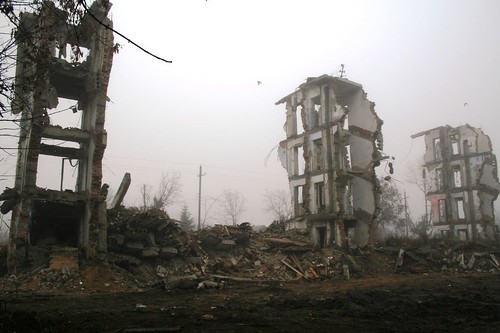 monuments of war – Grozny, originally uploaded by dziadek.mroz
monuments of war – Grozny, originally uploaded by dziadek.mroz
Urban Renewal and Partial Amnesia in Chechnya:
This is the year, according to an order from a president whom few dare to disappoint, that the architectural scars of war in Grozny, Chechnya’s capital, will be removed. That the order has nearly been fulfilled is a feat.
…
Grozny today is less a battlefield than the renovated seat of a new police state within Russia’s borders, led by Ramzan A. Kadyrov, the republic’s young and exceptionally violent president. And Mr. Kadyrov, a Chechen who has professed loyalty to the same Kremlin that many of his fellow Chechens fought for more than a decade, has decreed that by Dec. 31 his capital will bear no more of the marks of war that made Grozny worthy of its name.
As the makeover nears completion, and at a pace recalling the fear-driven public works of Stalin’s time, Grozny’s new look summons questions. The ruins are vanishing. How will the city remember the forces that destroyed it?
It just happens that I’m working on a paper discussing issues congruent with rebuilding cities after crises. There are usually two main groups: the Rebuilders and the Memorialists. The Rebuilders want to rebuild the city as expeditiously as possible, no matter that the underlying cause of the destruction was while Memorialists want a lighter tough, believing that the destruction should remain a memorial to the crisis, a living testament to the horror. Generally, the larger the destruction, the greater chance the Rebuilders have of winning.
You can see examples of both sides throughout history following major destruction caused by war: New York City on September 11th, where rebuilding as a sign that the terrorists hadn’t won
and Dresden, Germany in World War Two where many historic buildings were rebuilt. Almost every great disaster which envelops major sections of the urban fabric are rebuilt (see Nagasaki or Hiroshima, Tokyo or Berlin). Where Memorialists generally are able to persuade the populace that less is more, is in smaller scale crises and destruction. The Oklahoma City National Memorial or Gettysburg National Military Park are an example of memorializing horror, instead of rebuilding.
Editorializing, in the case of Chechnya, it is clear that the rebuilding is being done to paper over the human rights violations against Chechens by Russian troops. This is perhaps the primary reason Rebuilders have their way: the victors generally want to write history, and buildings are lasting testaments to the victor’s glory.









